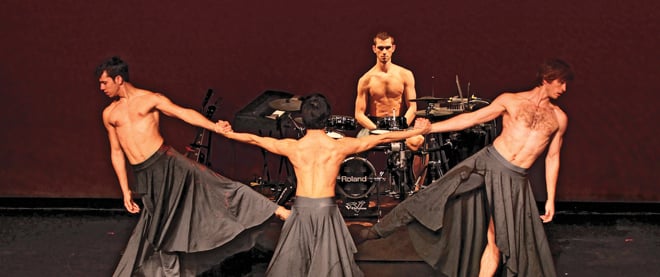Men in tights fight stereotype
The Alberta ballet’s male dancers put on a show of strength and athleticism
Share

Although Roxanne McCaig is a well-known supporter of the arts in Calgary and a season’s-ticket holder to the Alberta Ballet, it wasn’t easy to get her husband and two sons to accompany her to performances. Her two daughters? No problem.
“There’s a preconception somewhere along the line that ballet isn’t for men. But if you take them, they see something different,” McCaig said following a Saturday preview of a new hour-long work by the company’s 14 male dancers. Now her husband, a former logger raised in a mill town, gripes when she uses his tickets to take friends, and her boys now go often as well.
It’s not easy to get men to the ballet. In the oil patch, the closest most get is to watch a cowboy do a jeté off the back of a bronco at the Stampede.
This year, Dump the Physical Memory—followed by a whiskey- and wine-tasting event—will, the Alberta Ballet hopes, address the apprehensions some heterosexual men have about ballet. It was conceived during the AB’s staging of the über-feminine Swan Lake in March. “The problem with Swan Lake,” says artistic director Jean Grand-Maître, “is the men don’t get much to do.” Rather than languishing for five weeks while Swan Lake played, he challenged them to write, dance, score, costume and light their own show.
After the preview at the Margaret Greenham Theatre in Banff—where about 80 per cent of the audience was women—Grand-Maître pondered why it’s so hard getting straight men to go to a performance without being dragged in by wives and girlfriends. “Men aren’t afraid of ballet,” he suggested. “They’re afraid of tights. That’s a very different phobia.” It is an ingrained stereotype that male ballet dancers are gay or weak, as University of California, Irvine dance scholar Jennifer Fisher explored in her 2009 book, When Men Dance: Choreographing Masculinities Across Borders. Some of the invective flung their way: homosexual, wimp, spoiled, gay and dainty. But when Grand-Maître, who is gay, was dancing, he estimates 75 per cent of male dancers were homosexual; now, he says, the opposite is true. And reality shows such as So You Think You Can Dance have shown that ballet is cool, and that “a beautiful man dancing attracts women.”
Since he joined the AB in 2002, Grand-Maître has been trying to get men to shows with the usual bait: “I do that with beautiful women; women with breasts and busts,” not the stick figures he danced with and choreographed for in the ’80s and ’90s.
Sixty per cent of the Alberta Ballet’s season subscribers are women, but the male demographic has increased over the past few years, and even local NHL players have been showing up for performances. “There is a growing interest in the athleticism that is associated with ballet, which provides a broader-based appeal to our audience,” says executive director Martin Bragg. That includes straight men who have come to see Love Lies Bleeding, the homoerotic, men-in-high-heels hit set to Elton John’s music that traces his battle with drugs, love and homophobia.
Aside from Dump the Physical Memory, about the only other place you’d see so much muscularity, athleticism and high-flying kicks might be in an ultimate fighting octagon. And men love the UFC, even if the grappling, sweaty combatants wear Lycra skivvies every bit as suggestive as a codpiece. The truth is that ballet was originally a dance interpretation of fencing, an all-male martial art.
Grand-Maître left it to the AB’s dynamic 31-year-old lead dancer, Yukichi Hattori, to choreograph the show, with music played mostly live on guitar, piano and drums by dancer Davidson Jaconello. If its underlying motive was to man-up ballet’s image, Hattori takes a surprisingly gender-neutral approach. The shirtless men wear a costume that is part skirt, part one-legged tight. Nevertheless, there’s a tribal ferocity and a chest-thumping militarism underpinning the piece, which sold out as soon as it was announced. But Hattori, who is straight, doesn’t like to give stereotypes any voice at all, even to negate them. “That problem, in 2012, really shouldn’t be an issue,” he says.